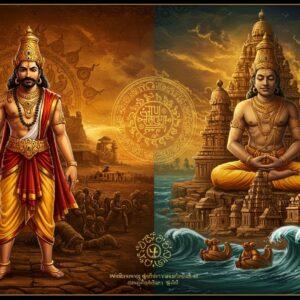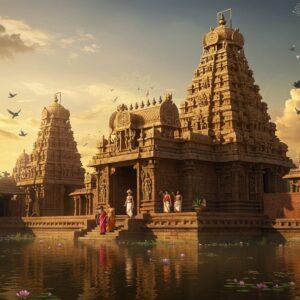
In Hindu philosophy, the concepts of Tridasha and Moksha hold profound spiritual significance. Tridasha, often referred to as the Trimurti, represents the divine trinity of Brahma, Vishnu, and Shiva, embodying creation, preservation, and transformation, respectively. This trinity symbolizes the cyclical nature of the universe, a continuous process of creation, sustenance, and change. Moksha, on the other hand, signifies liberation from this cycle of birth and rebirth (samsara), representing the ultimate spiritual goal in Hinduism.
Understanding Tridasha: The Divine Trinity
The Trimurti—Brahma, Vishnu, and Shiva—represents the fundamental forces governing the universe. Brahma, the creator, brings forth all beings and existence. Vishnu, the preserver, sustains the universe and upholds dharma, the cosmic order. Shiva, often associated with destruction, is more accurately understood as the transformer, facilitating change and renewal. These deities work in harmony, maintaining balance and driving the cosmic cycle.
The Concept of Moksha: Liberation and Enlightenment
Moksha is the ultimate aspiration in Hinduism, signifying liberation from samsara, the continuous cycle of birth, death, and rebirth. It represents freedom from the suffering and limitations of the material world. Achieving Moksha involves transcending ignorance and realizing one’s true self, leading to a state of eternal peace and unity with the divine. This state of liberation can also be attained during one’s lifetime, known as Jivanmukti, where an individual experiences a profound shift in consciousness and behavior.
In addition to liberation from samsara, Moksha also signifies freedom from avidya, or ignorance. This freedom is achieved through self-realization and self-knowledge, allowing the individual to experience their true nature and connection to the divine. The soul, considered spiritual, eternal, simple, conscious, and immortal, is seen as being “liberated” from the confines of the physical body.
Paths to Moksha: Diverse Spiritual Practices
Hinduism offers various paths (Yogas) to achieve Moksha, each catering to different temperaments and inclinations:
- Bhakti Yoga (Path of Devotion): This path emphasizes loving devotion to a chosen deity through prayer, chanting, rituals, and selfless service. It involves cultivating a deep personal relationship with the divine, seeking union through love and surrender.
- Jnana Yoga (Path of Knowledge): This path focuses on acquiring spiritual knowledge and self-realization through studying scriptures, contemplation, and meditation. It involves understanding the nature of reality and the self, leading to enlightenment through wisdom. This path involves dedicating oneself to the pursuit of knowledge and wisdom, understanding one’s true self and the nature of Brahman.
- Karma Yoga (Path of Action): This path emphasizes performing actions selflessly, without attachment to results, dedicating all actions to a higher purpose. It involves fulfilling one’s dharma and dedicating actions to the divine without selfish motives.
- Raja Yoga (Path of Meditation): This path combines physical and mental disciplines, including postures (asanas), breathing exercises (pranayama), and meditation, to control the mind and achieve a state of inner peace. It involves disciplined practice to achieve control over the mind and senses.
It is important to note that Bhakti or loving devotion to God is considered the immediate means of liberation. A seeker should cultivate a sense of reverence for the world and interact with all beings through the principle of ahimsa, or universal love.
The Trinity’s Role in Moksha: Guidance and Transformation
While interpretations vary, the Trimurti’s influence on the path to Moksha is significant. Brahma‘s role as creator connects to knowledge and wisdom, essential for understanding the path to liberation. Vishnu‘s preservation of dharma helps devotees stay on the righteous path, overcoming obstacles on their spiritual journey. Shiva, as the transformer, facilitates the destruction of ignorance and attachments, paving the way for spiritual growth. The Trimurti embodies the cycle of creation, preservation, and dissolution, closely tied to the concept of samsara, which individuals on the path to Moksha seek to transcend. Some Vaishnavas believe that desiring Moksha is selfish, advocating for prema (love of God) or nitya-lila (experiencing the Lord’s eternal pastimes).Learn more about Hindu scriptures to enhance your spiritual understanding.
Poojn.in: Supporting Your Spiritual Journey
Poojn.in, India’s largest cultural goods and services store, provides a wide range of products to support your spiritual practices related to Tridasha and the pursuit of Moksha. Explore our collection of:
- Sandalwood Incense Sticks: Create a sacred atmosphere for your prayers and meditation.
- Brass Laddu Gopal Murti: Enhance your devotion to Lord Krishna.
- Puja Samagri Kits: Find all the essential items for your rituals and ceremonies.
- Sandalwood Puja Prayer Agarbatti: Enhance your spiritual practices.
- Planning Your Spiritual Retreat: Consider an ashram stay for a deeper spiritual experience.
Visit www.poojn.in today to explore our complete collection and enhance your spiritual journey.


